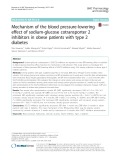
Osmotic diuresis
-
Sodium-glucose cotransporter 2 (SGLT2) inhibitors are reported to have BP-lowering effect in addition to blood glucose-lowering effect, however, its mechanism is still unknown. This study aimed to investigate the mechanism of blood pressure (BP) lowering effects of SGLT2 inhibitors using 24-h urinary collection in obese type 2 diabetes patients.
 10p
10p  vienzym2711
vienzym2711
 30-03-2020
30-03-2020
 15
15
 2
2
 Download
Download
-
Table 46-3 Causes of Hypokalemia I. Decreased intake A. Starvation B. Clay ingestion II. Redistribution into cells A. Acid-base 1. Metabolic alkalosis B. Hormonal 1. Insulin 2. β2-Adrenergic agonists (endogenous or exogenous) 3. α-Adrenergic antagonists C. Anabolic state 1. Vitamin B12 or folic acid (red blood cell production) 2. Granulocyte-macrophage colony stimulating factor (white blood cell production) 3. Total parenteral nutrition D. Other 1. Pseudohypokalemia 2. Hypothermia 3. Hypokalemic periodic paralysis 4. Barium toxicity III. Increased loss A.
 5p
5p  ongxaemnumber1
ongxaemnumber1
 29-11-2010
29-11-2010
 106
106
 5
5
 Download
Download
-
Figure 46-2 Many causes of hypernatremia are associated with polyuria and a submaximal urine osmolality. The product of the urine volume and osmolality, i.e., the solute excretion rate, is helpful in determining the basis of the polyuria (see above). To maintain a steady state, total solute excretion must equal solute production. As stated above, individuals eating a normal diet generate ~600 mosmol/d. Therefore, daily solute excretion in excess of 750 mosmol defines an osmotic diuresis.
 5p
5p  ongxaemnumber1
ongxaemnumber1
 29-11-2010
29-11-2010
 74
74
 6
6
 Download
Download
-
Hypovolemia Etiology True volume depletion, or hypovolemia, generally refers to a state of combined salt and water loss exceeding intake, leading to ECF volume contraction. The loss of Na+ may be renal or extrarenal (Table 46-1). Table 46-1 Causes of Hypovolemia I. ECF volume contracted A. Extrarenal Na+ loss 1. Gastrointestinal (vomiting, nasogastric suction, drainage, fistula, diarrhea) 2. Skin/respiratory (insensible losses, sweat, burns) 3. Hemorrhage B. Renal Na+ and water loss 1. Diuretics 2. Osmotic diuresis 3. Hypoaldosteronism 4. Salt-wasting nephropathies C.
 5p
5p  ongxaemnumber1
ongxaemnumber1
 29-11-2010
29-11-2010
 61
61
 4
4
 Download
Download
CHỦ ĐỀ BẠN MUỐN TÌM
















